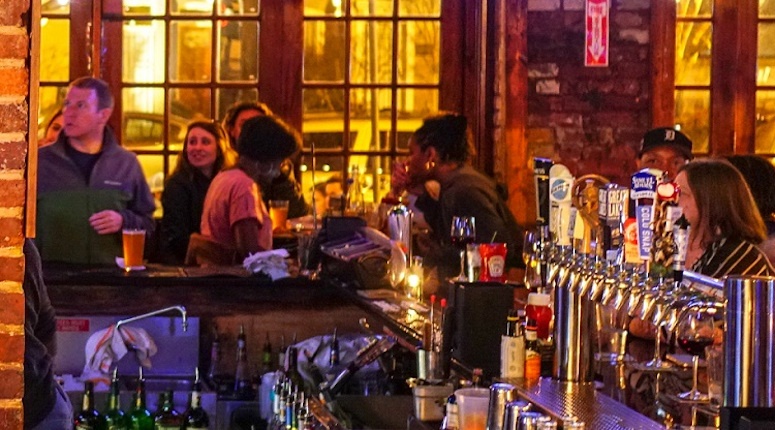
Restaurants as high-risk COVID-19 hotspots? A study of the US CDC
The US CDC suggests in a study that restaurants could be the main hotspot to get COVID-19. The study investigated data from 314 adults who showed COVID-19 symptoms of and were tested at a variety of centers around the United States.
Eating and drinking at restaurants may result to be an especially high-risk activity during this ongoing COVID-19 pandemic. Below the explanation of the US CDC study.
COVID-19 and restaurants: the study of the US CDC
All the tested subjects allowed the researchers to gather detailed demographic and behavioral data. The researchers compared both positive and negative cases, found no differences between the two groups in most behavioral patterns.
According to the study, both groups practised similar rates of mask-wearing, gyms and hair salon visitations and both groups consistently used public transport. Although of all of this, those positive COVID-19 cases were twice as likely to have eaten in a restaurant compared to those in the negative control group.
The study is admittedly quite limited in that it does not specifically focus on individual routes of transmission. That is to say, the study does not claim the positive COVID-19 cases stemmed from exposure inside restaurants. But instead, the research is designed to identify those environments where people may be most at risk of contracting the disease.
It is hypothesized restaurants may be intrinsically higher risk environments due to the necessity of having to take masks off to eat. Enclosed environments with often boisterous conversation and no consistent facial covering are factors that all coalesce to make restaurants particularly challenging locations for COVID-19 safety measures.
Discussion on restaurants impact on COVID-19 cases
According to what reported by the US CDC, this investigation saw participants with and without COVID-19 reported generally similar community exposures, with the exception of going to locations with on-site eating and drinking options.
“Adults with confirmed COVID-19 (case-patients) were approximately twice as likely as were control-participants to have reported dining at a restaurant in the 14 days before becoming ill. In addition to dining at a restaurant, case-patients were more likely to report going to a bar/coffee shop, but only when the analysis was restricted to participants without close contact with persons with known COVID-19 before illness onset. Reports of exposures in restaurants have been linked to air circulation. Direction, ventilation, and intensity of airflow might affect virus transmission, even if social distancing measures and mask use are implemented according to current guidance. Masks cannot be effectively worn while eating and drinking, whereas shopping and numerous other indoor activities do not preclude mask use.”
42% of adults with COVID-19 reported close contact with a person with COVID-19, similar to what has been reported previously. CDC reports again “Most close contact exposures were to family members, consistent with household transmission of SARS-CoV-2. Fewer (14%) persons who received a negative SARS-CoV-2 test result reported close contact with a person with known COVID-19. To help slow the spread of SARS-CoV-2, precautions should be implemented to stay home once exposed to someone with COVID-19, in addition to adhering to recommendations to wash hands often, wear masks, and social distance. If a family member or other close contact is ill, additional prevention measures can be taken to reduce transmission, such as cleaning and disinfecting the home, reducing shared meals and items, wearing gloves, and wearing masks, for those with and without known COVID-19.”
CDC – Clear findings on COVID-19 infection in restaurants
“The findings in this report are subject to at least five limitations. First, the sample included 314 symptomatic patients who actively sought testing during July 1–29, 2020 at 11 health care facilities. Symptomatic adults with negative SARS-CoV-2 test results might have been infected with other respiratory viruses and had similar exposures to persons with cases of such illnesses.
Persons who did not respond, or refused to participate, could be systematically different from those who were interviewed for this investigation. Efforts to age- and sex-match participating case-patients and control-participants were not maintained because of participants not meeting the eligibility criteria, refusing to participate, or not responding, and this was accounted for in the analytic approach. Second, unmeasured confounding is possible, such that reported behaviors might represent factors, including concurrently participating in activities where possible exposures could have taken place, that were not included in the analysis or measured in the survey.
Of note, the question assessing dining at a restaurant did not distinguish between indoor and outdoor options. In addition, the question about going to a bar or coffee shop did not distinguish between the venues or service delivery methods, which might represent different exposures. Third, adults in the study were from one of 11 participating health care facilities and might not be representative of the United States population. Fourth, participants were aware of their SARS-CoV-2 test results, which could have influenced their responses to questions about community exposures and close contacts. Finally, case or control status might be subject to misclassification because of imperfect sensitivity or specificity of PCR-based testing.
This investigation highlights differences in community and close contact exposures between adults who received a positive SARS-CoV-2 test result and those who received a negative SARS-CoV-2 test result. Continued assessment of various types of activities and exposures as communities, schools, and workplaces reopen is important. Exposures and activities where mask use and social distancing are difficult to maintain, including going to locations that offer on-site eating and drinking, might be important risk factors for SARS-CoV-2 infection. Implementing safe practices to reduce exposures to SARS-CoV-2 during on-site eating and drinking should be considered to protect customers, employees, and communities and slow the spread of COVID-19.”

